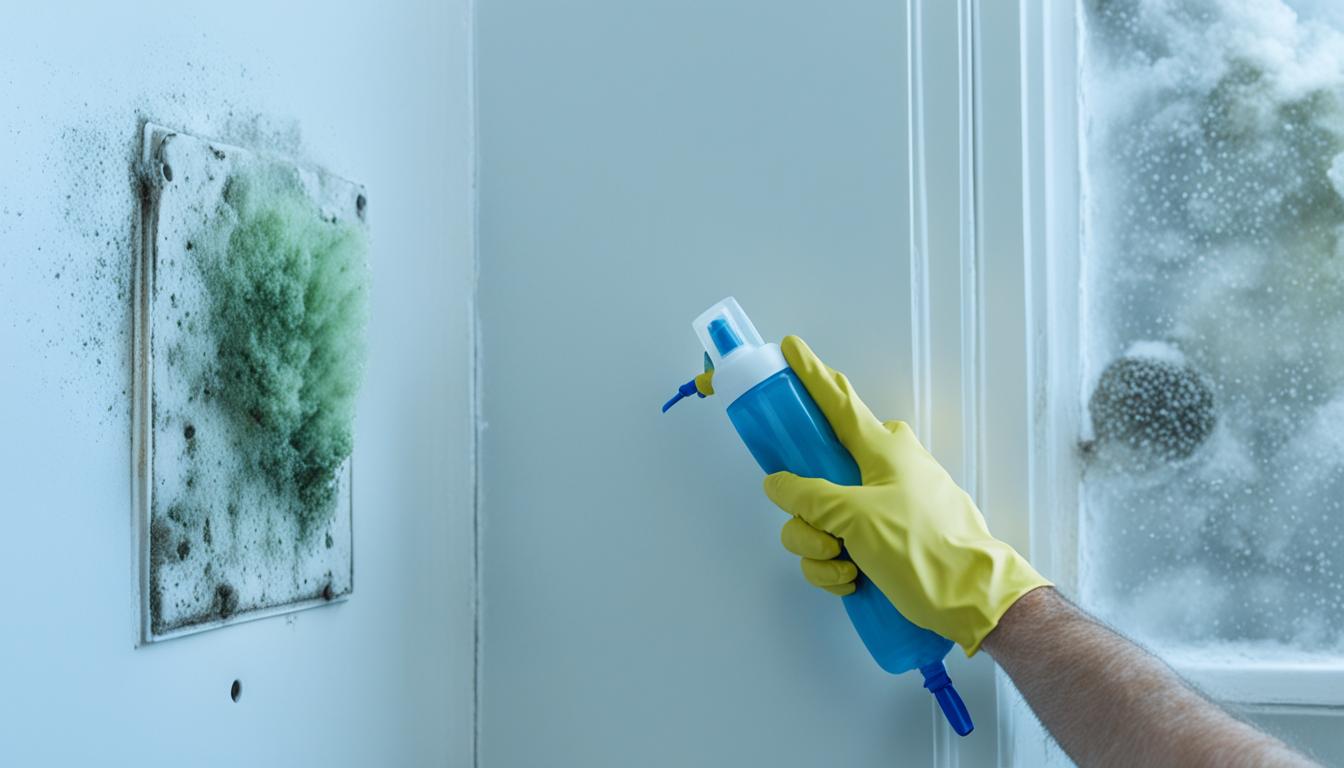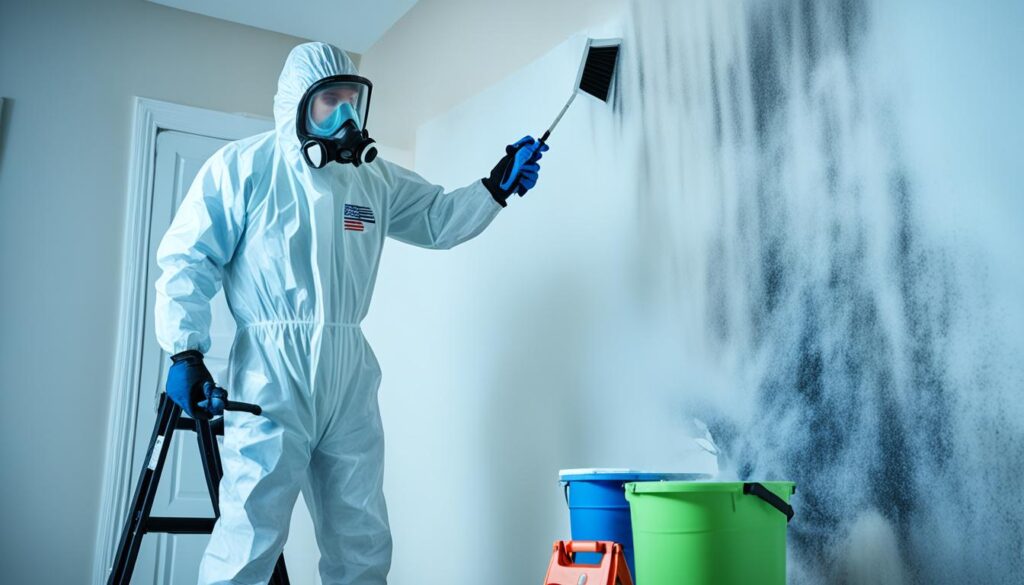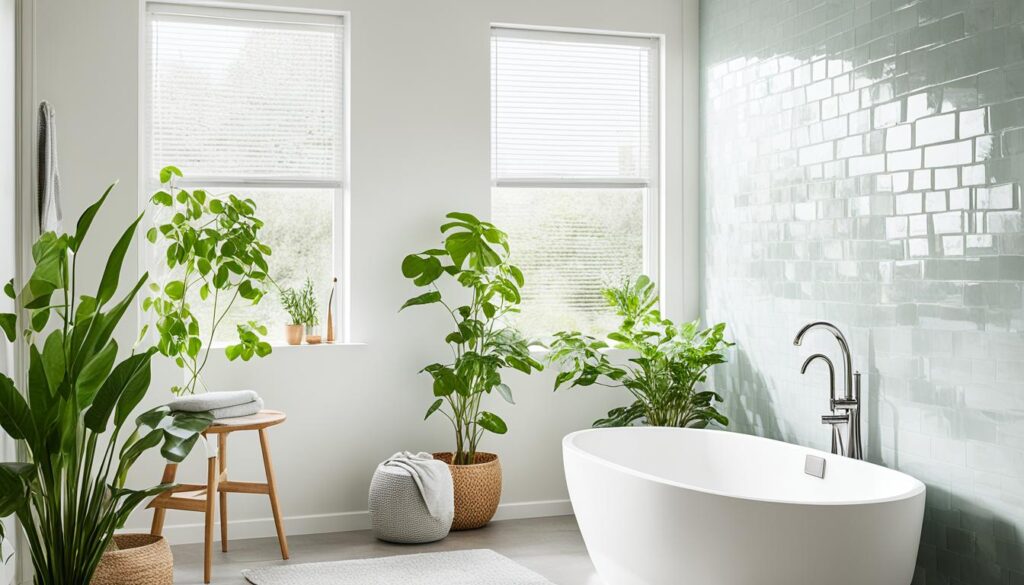
Mold Remediation Guide: How to Fix Mold in House
Welcome to our comprehensive mold remediation guide, where we will provide you with valuable insights and step-by-step instructions on how to effectively fix mold in your house. Mold growth can pose numerous health risks and cause structural damage to your home, so it’s essential to address the issue promptly.
Mold can thrive in areas with excess moisture, such as bathrooms, basements, and kitchens. If left untreated, it can spread quickly and become a more significant problem. That’s why it’s crucial to take immediate action to eliminate mold and prevent future growth.
Key Takeaways:
- Promptly addressing mold problems is crucial for protecting your health and your home’s structural integrity.
- Mold can thrive in damp areas, so it’s important to control humidity levels and keep your home dry.
- Identifying the severity of the mold problem will help determine whether you can handle the removal yourself or if you need to seek professional assistance.
- Regularly inspecting your home for mold and addressing any issues promptly can prevent mold growth and the need for extensive remediation.
- Proper ventilation and air circulation are essential in preventing mold growth in your house.
Mold Removal Techniques: DIY Mold Removal and Professional Remediation
In this section, we will explore various mold removal techniques to help you tackle mold in your home effectively. Whether you prefer a hands-on approach or seek professional assistance, we will provide you with valuable information on DIY mold removal methods and the mold remediation process.
Identifying the Severity of the Mold Problem
Before deciding whether to handle mold removal yourself or hire professionals, it is crucial to assess the severity of the mold problem. Conduct a thorough inspection of the affected areas to determine the extent of the mold growth. Keep an eye out for visible mold, musty odors, and water damage. If you notice widespread mold growth or suspect structural damage, it is advisable to consult a professional mold remediation service for a comprehensive assessment.
DIY Mold Removal Techniques
If the mold growth is minimal, and you feel confident in your abilities, you can attempt to remove it yourself using DIY mold removal techniques. Here are some steps to follow:
- Gather the necessary tools and protective equipment: Before starting the mold removal process, equip yourself with gloves, goggles, a mask, and a disposable coverall suit to protect yourself from mold spores.
- Contain the affected area: Seal off the mold-infested area using plastic sheets or tarps to prevent the spread of mold spores to other parts of the house.
- Remove mold-infested materials: If the mold growth has affected porous materials like drywall or carpeting, it may be necessary to remove and replace them. Thoroughly clean non-porous surfaces, such as tiles or countertops, using a mold-specific cleaner.
- Clean and dry: Scrub the mold-affected surfaces using a mixture of water and detergent. Ensure the area is dried completely to discourage further mold growth.
- Monitor for recurrence: Keep a close eye on the treated area for any signs of mold regrowth. Address any moisture or humidity issues promptly to prevent future mold problems.
The Mold Remediation Process
In cases where the mold growth is extensive or poses health and safety risks, it is recommended to seek professional mold remediation services. Trained technicians have the expertise, specialized equipment, and knowledge to handle large-scale mold removal effectively. The mold remediation process typically involves the following steps:
- Initial assessment and containment: Professionals will conduct a thorough inspection to assess the extent of the mold problem. They will implement containment measures to prevent the spread of mold spores during the removal process.
- Removal of mold-infested materials: The professionals will safely remove and discard mold-infested materials, such as drywall or insulation, to eliminate the source of mold growth.
- Cleaning and disinfection: All affected surfaces will be thoroughly cleaned and disinfected using specialized products to ensure the complete removal of mold spores.
- Air filtration and drying: High-efficiency particulate air (HEPA) filtration systems will be used to capture any lingering mold spores in the air. The professionals will also implement drying techniques to eliminate excess moisture.
- Post-remediation assessment: After completing the mold remediation process, professionals will conduct a final assessment to ensure the successful removal of mold and verify that the affected area is safe for occupation.
Whether you choose DIY mold removal or opt for professional mold remediation, it is essential to address mold problems promptly to safeguard your health and protect the integrity of your home.

Preventing Mold Growth: Tips for Mold Prevention and Eliminating Stains
Preventing mold growth in your house is essential to protect your health and maintain the integrity of your home. By taking proactive measures, you can minimize the risk of mold infestation and eliminate mold stains effectively. Here are some crucial tips to help you prevent mold growth and get rid of pesky stains.
Controlling Humidity Levels
High humidity levels create an ideal environment for mold to thrive. To prevent mold growth, it’s crucial to keep the humidity in your home under control. You can achieve this by:
- Using dehumidifiers in areas prone to moisture, such as basements, bathrooms, and laundry rooms.
- Ensuring proper ventilation in your home by opening windows, using exhaust fans, and installing air vents.
- Fixing any leaks or water intrusions promptly to prevent moisture buildup.
Improving Ventilation
Good air circulation helps prevent mold growth by keeping surfaces dry and reducing moisture buildup. Here are some ways to improve ventilation and minimize mold risk:
- Install and use exhaust fans in kitchens and bathrooms to remove excess moisture.
- Ensure that attics and crawl spaces are properly ventilated to prevent trapped moisture.
- Open windows and doors regularly to promote air circulation, especially in areas prone to humidity.
Keeping Your Home Dry
Keeping your home dry is crucial in mold prevention. Take these steps to maintain a dry indoor environment:
- Wipe down surfaces that are prone to moisture, such as windowsills and bathroom walls, regularly.
- Repair any plumbing leaks immediately to prevent water damage and mold growth.
- Ensure that gutters and downspouts are clear and functioning properly to avoid water seepage into your home.
Eliminating Mold Stains
If you already have mold stains in your home, it’s important to tackle them promptly to prevent further mold growth. Here are effective methods for eliminating mold stains:
- Use a mixture of water and detergent to scrub mold stains from hard surfaces.
- Apply a bleach solution (1 cup of bleach to 1 gallon of water) to remove mold stains from non-porous materials like tiles and countertops. Remember to wear protective gloves and ensure proper ventilation when using bleach.
- For porous surfaces like fabrics and carpets, consider professional cleaning or replacement.
| Preventive Measures | Mold Stain Elimination Techniques |
|---|---|
| Controlling humidity levels | Water and detergent scrub |
| Improving ventilation | Bleach solution |
| Keeping your home dry | Professional cleaning or replacement for fabrics and carpets |
By following these preventive measures and effectively eliminating mold stains, you can create a mold-free environment in your home. Regular maintenance, prompt action, and appropriate cleaning techniques are key to mold prevention and a healthy living space.

Conclusion
In conclusion, addressing mold issues promptly in your house is crucial for both your health and the structural integrity of your home. Mold can cause respiratory problems and allergies, and if left unchecked, it can lead to significant damage to your property.
To ensure effective mold removal, it is essential to follow proper black mold cleanup procedures. This includes wearing protective gear, containing the affected area, removing contaminated materials, and thoroughly cleaning and disinfecting the space. If the mold infestation is extensive or if you are unsure about the proper techniques, it is advisable to seek professional mold remediation services for efficient and safe cleanup.
Regular mold inspections are also important to identify any potential mold growth and address it before it becomes a larger problem. Conducting a mold inspection checklist can help you thoroughly assess your property for mold indicators, such as musty odors, visible mold growth, or water damage.
Contact Fix Mold Miami for professional mold assessments and remediation services. Our team of experts can provide comprehensive mold inspections, develop effective remediation plans, and ensure your home is free from mold hazards. Don’t let mold compromise your health and property – take proactive steps to eliminate it today.




